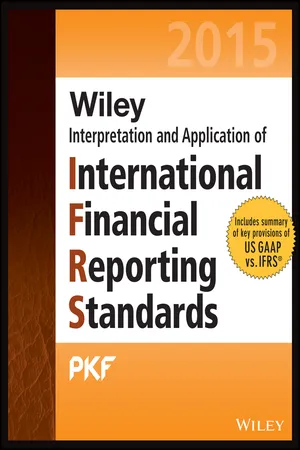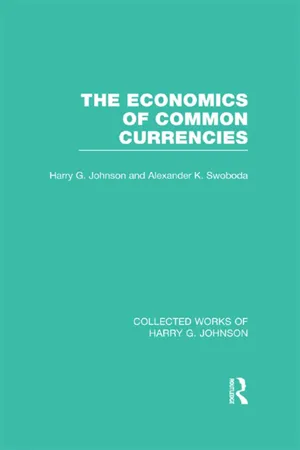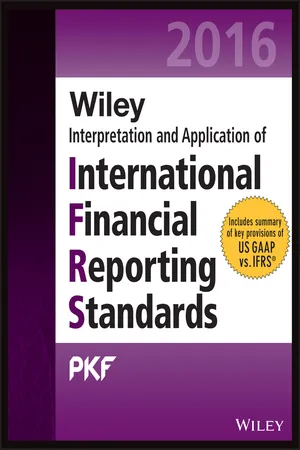Economics
Foreign Currency Assets
Foreign currency assets refer to assets held in the form of foreign currencies, such as foreign bank deposits, government securities, and other financial instruments denominated in a foreign currency. These assets are typically held by central banks, governments, and financial institutions as a means of diversifying their investment portfolios and managing foreign exchange risk.
Written by Perlego with AI-assistance
Related key terms
Related key terms
1 of 4
Related key terms
1 of 3
3 Key excerpts on "Foreign Currency Assets"
- eBook - ePub
Wiley IFRS 2015
Interpretation and Application of International Financial Reporting Standards
- (Author)
- 2015(Publication Date)
- Wiley(Publisher)
Foreign currency transactions. Transactions whose terms are denominated in a foreign currency or require settlement in a foreign currency. Foreign currency transactions arise when an entity:1. Buys or sells goods or services whose prices are denominated in foreign currency;2. Borrows or lends funds and the amounts payable or receivable are denominated in foreign currency;3. Is a party to an unperformed foreign exchange contract; or4. For other reasons acquires or disposes of assets or incurs or settles liabilities denominated in foreign currency.Foreign currency translation. The process of expressing in the presentation currency of the entity amounts that are denominated or measured in a different currency.Foreign entity. When the activities of a foreign operation are not an integral part of those of the reporting entity, such a foreign operation is referred to as a foreign entity.Foreign operation. A foreign subsidiary, associate, joint venture, or branch of the reporting entity whose activities are based or conducted in a country other than the country where the reporting entity is domiciled.Functional currency. The currency of the primary economic environment in which the entity operates, which thus is the currency in which the reporting entity measures the items in its financial statements, and which may differ from the presentation currency in some instances.Group. A parent company and all of its subsidiaries.Monetary items. Money held and assets and liabilities to be received or paid in fixed or determinable amounts of money.Net investment in a foreign operation. The amount refers to the reporting entity’s interest in the net assets of that foreign operation.Nonmonetary items. All items presented in the statement of financial position other than cash, claims to cash, and cash obligations.Presentation currency. - eBook - ePub
The Economics of Common Currencies
Proceedings of the Madrid Conference on Optimum Currency Areas
- Harry Johnson, Alexander Swoboda(Authors)
- 2013(Publication Date)
- Routledge(Publisher)
International Financial Statistics. Interest rates on domestic assets are those shown for money market investment in each country in the country pages. Interest rates on external deposits denominated in currencies other than the dollar are computed using the Eurodollar deposit rate and the forward exchange rate for each currency.1 For a succinct discussion of controls applied by the national authorities to external currency transactions, see Donald R. Hodgman, Eurodollars and National Monetary Policies (Irving Trust Company).2 Assume there is a shift from domestic Swiss franc deposits to external Swiss franc deposits. Swiss banks must find a new source to fund loans formerly financed by the runaway domestic deposits, so they will chase their borrowers to the external market. Assume now that the supply of external Swiss franc deposits increases as a result of currency transformation by foreigners. ECBS which issue these deposits may find it more attractive to lend in currencies other than the Swiss franc, even after covering themselves against the exchange risk.Passage contains an image Chapter 11
JOINT BALANCE: CAPITAL MOBILITY AND THE MONETARY SYSTEM OF A CURRENCY AREA*SVEN W. ARNDTUniversity of California, Santa CruzWhen two countries enter into a monetary union, the consequent extension of their mutual dependence impinges upon the nature and ordering of their economic goals and alters both qualitatively and quantitatively the policy instruments in their individual and joint possessions. The adoption of a uniform currency effectively removes the monetary instrument from the individual country’s arsenal, and the freedom to employ fiscal controls is restricted because the transfer of monetary powers to the community constrains the available means of financing government outlays. The latter constraints operate even where each member country retains the right to issue the common money, for monetary conditions within any country are inseparably tied to conditions in the area at large. - eBook - ePub
Wiley IFRS 2016
Interpretation and Application of International Financial Reporting Standards
- (Author)
- 2016(Publication Date)
- Wiley(Publisher)
For purposes of applying IAS 21, it is important to understand the distinction between monetary and non-monetary items. Monetary items are those granting or imposing “a right to receive, or an obligation to deliver, a fixed or determinable number of units of currency.” In contrast, non-monetary items are those exhibiting “the absence of a right to receive, or an obligation to deliver, a fixed or determinable number of units of currency.” Examples of monetary items include accounts and notes receivable; pensions and other employee benefits to be paid in cash; provisions that are to be settled in cash; and cash dividends that are properly recognized as a liability. Examples of non-monetary items include inventories; amounts prepaid for goods and services (e.g., prepaid insurance); property, plant and equipment; goodwill; other intangible assets; and provisions that are to be settled by the delivery of a non-monetary asset.Foreign Currency Transactions
Foreign currency transactions are those denominated in, or requiring settlement in, a foreign currency. These can include such common transactions as those arising from:- The purchase or sale of goods or services in transactions where the price is denominated in a foreign currency;
- The borrowing or lending of funds, where the amounts owed or to be received are denominated in a foreign currency; or
- Other routine activities such as the acquisition or disposal of assets, or the incurring or settlement of liabilities, if denominated in a foreign currency.
Under the provisions of IAS 21, foreign currency transactions are to be initially recorded in the functional currency by applying to the foreign-currency-denominated amounts the spot exchange rate between the functional currency and the foreign currency at the date of the transaction. However, when there are numerous, relatively homogeneous transactions over the course of the reporting period (e.g., year), it is acceptable, and much more practical, to apply an appropriate average exchange rate provided such an average would approximate the spot rates applicable. In the simplest scenario, the simple numerical average (i.e., the midpoint between the beginning and ending exchange rates) could be used. Care must be exercised to ensure that such a simplistic approach is actually meaningful, however.If exchange rate movements do not occur smoothly throughout the reporting period, or if rates move alternately up and down over the reporting interval, rather than monotonically up or down, then a more carefully constructed, weighted-average exchange rate should be used. Also, if transactions occur in other than a smooth pattern over the period—as might be the case for products characterized by seasonal sales—then a weighted-average exchange rate might be needed if exchange rates have moved materially over the course of the reporting period. For example, if the bulk of revenues is generated in the fourth quarter, the annual average exchange rate would probably not result in an accurately translated statement of comprehensive income.
Index pages curate the most relevant extracts from our library of academic textbooks. They’ve been created using an in-house natural language model (NLM), each adding context and meaning to key research topics.
Explore more topic indexes
Explore more topic indexes
1 of 6
Explore more topic indexes
1 of 4


